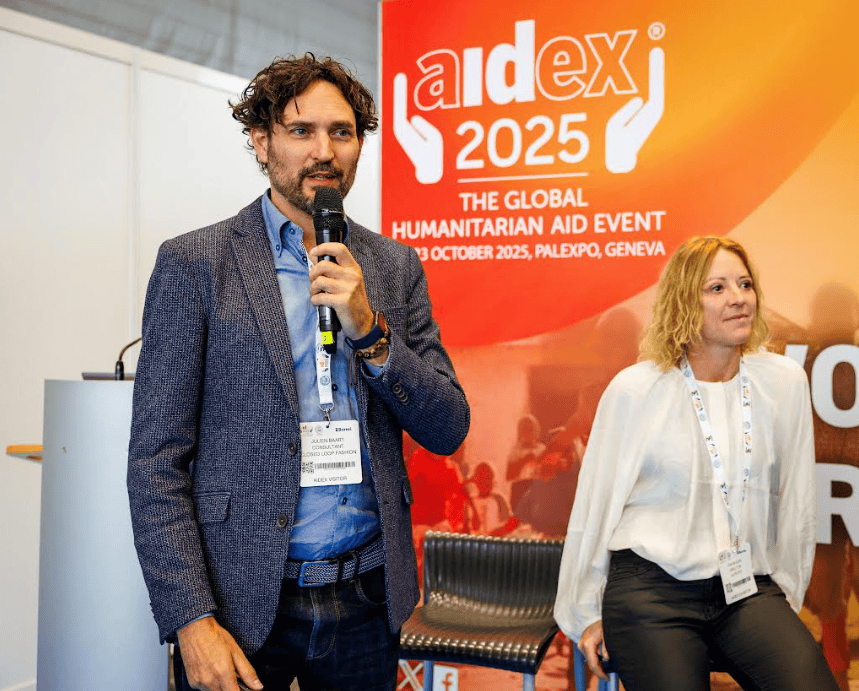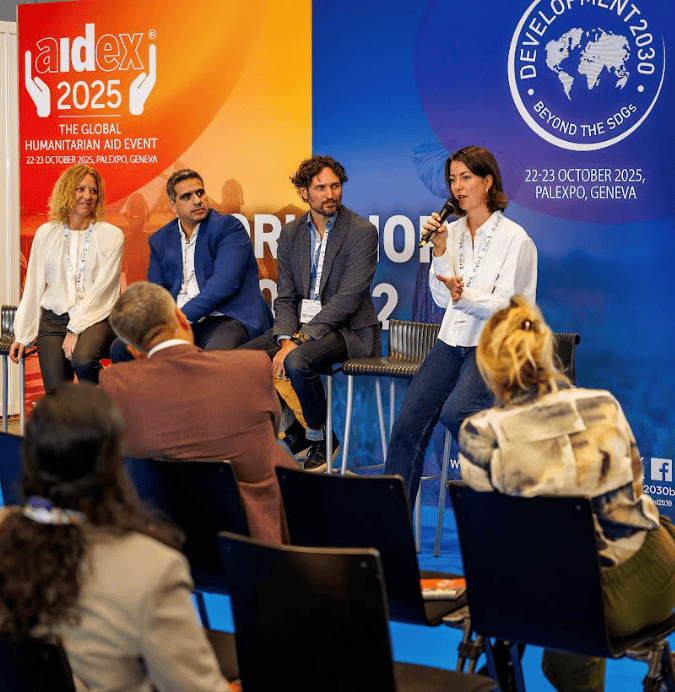This year’s AidEx, the world’s largest annual event for aid and development, took place in Geneva on the 22-23 of October, bringing together over 3,000 delegates from local and international NGOs, UN agencies, government bodies and industry partners. The theme was, “Future-Proofing Humanitarian Aid,” which explored how the sector can strengthen its resilience and adaptability in the face of evolving global challenges. Closed Loop Fashion joined partners Alpinter and H. Nizam Din & Sons (Pvt) Ltd to present the results of their joint efforts to embed sustainability and circularity into humanitarian shelter tents. The presentation, delivered as part of AidEx’s main conference programme, shared the outcomes of a comprehensive Life-Cycle-Assessment (LCA) on three different tent models and introduced new circular design scenarios developed from the findings.
The case study was presented by Jenny Puts (Sustainability & Circularity Impact Strategist Consultant) and Julien Baart (Sustainable Textiles Supply Chains Consultant) of Closed Loop Fashion, as well as our esteemed project partners Ali Ahmed (CEO of Nizam) and Fem Mulier (Director of Alpinter). The LCA quantified the environmental impacts of the tents from raw material extraction to end-of-life and revealed key hotspots across the supply chain.
These results served as the basis for a series of circular design scenarios built around three core principles:
- Design for durablability: Reducing hotspots of wear & tear
- Redesigning for after-use: Keeping the tents and its materials in use for longer in the refugee camps through guided repair and repurposing (design for disassembly)
- Closed-loop material cycles: Reducing the use of virgin materials through the recycling of the tent productions’s post-industrial waste
Together, these strategies outline a pathway toward tents that are not only more resource-efficient but also better aligned with the growing sustainability requirements in humanitarian procurement.


A highlight of the session was the contribution from students of Nadirshaw Edulji Dinshaw (NED) University Pakistan, who supported the project with creative design concepts that reimagined the role of circularity in shelter systems. The presentation drew an engaged audience, which then shifted into an interactive Q&A where participants discussed opportunities and challenges for scaling circular design across the relief sector.
This year’s AidEx programme reflected the challenging circumstances the humanitarian aid and development sector is currently facing. With budgets tightening and funding being reduced, many sessions focused on innovative financing models and strengthening supply-chain resilience. While financial considerations were taking a more prominent place in discussions, sustainability remains a key requirement, particularly as suppliers are increasingly expected to demonstrate effective waste management, end-of-life solutions, and product take-back systems. The conversations also highlighted the ongoing challenge of end-of-life management for shelter products in camps.
What can be a takeaway from AidEx 2025 is that sustainability should not be seen as a costly alternative, but as a smarter and more efficient way forward. As our project has reflected that eliminating unnecessary materials, improving product longevity, and introducing repair and recycling systems, circularity can reduce both costs and environmental impact. The case study presented at AidEx 2025 made clear that applying circular design to humanitarian products is not only feasible but necessary to ensure that the sector’s life-saving missions are also aligned with global sustainability goals.
This Case Study was developed in the framework of the Enhancing Circularity in Disaster Relief Tents project, which is co-financed by the German Investment and Development Corporation / DEG Impulse gGmbH from public funds of the German Federal Ministry for Economic Cooperation and Development (BMZ) and H. Nizam Din & Sons Private Limited and has been conceptualised and implemented by expert consultants of Closed Loop Fashion & World of Tents/Alpinter SA.

All photos by Marc Bader


